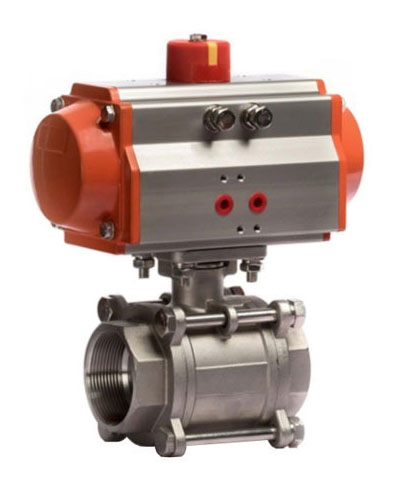Pneumatic ball valve is a device operated by compressed air to open and close the valve. It just requires air source to work and the switching speed is very fast, which saves human resources and time to a great extent. In addition, it can carry out remote centralized control and do not need to go to the scene or high altitude and dangerous to bring manual operation, which greatly improve and ensure the safety of use. When the pneumatic ball valve in use cannot meet the operating requirements, or after a long period of operation in order to regular inspection and prevent accidents, it must be carefully maintained and repaired. Doing a good job in daily use and maintenance of pneumatic ball valve can effectively improve the efficiency of the use of products, and reduce unnecessary losses.
How to maintain the pneumatic ball valve?
 Before using the pneumatic ball valve, you should clean the iron filings and other debris in the valve body with clean water.
Before using the pneumatic ball valve, you should clean the iron filings and other debris in the valve body with clean water.- Fully open and fully close the pneumatic ball valve several times to make sure it can work normally, and roundly check all details of the ball valve again to ensure it is intact.
- Check regularly the bearing and supporting frame.
- If the sealing gasket between the valve body and the valve check is used for a long time, it should be replace in time. When replacing, only remove the valve cover to place the new gasket.
- If there is leakage in the stuffing box, replace the sealing packing in time. When replacing, remove the valve stem, the pressing plate and packing gland, and then load the new sealing packing.
- In case of pneumatic valve closing, there are some remaining media in the valve body of the pneumatic valve, and the power supply and air source must be cut off to release all the pressure for cleaning.
- The sealing material of the pneumatic actuated ball valve should be clean regularly to prevent leakage and wear.
- If you do not use the pneumatic ball valve for a long time, it should install a protective cover for connecting flange and block all connector with plastic plugs. Ensure the air valve is stored in verticality or horizontal position.
- Ensure that the installation position of the pneumatic valve pipeline is in the coaxial position, the two flanges of the pipeline should be kept parallel, confirm that the pipeline can bear the weight of the pneumatic ball valve itself, if it is found that the pipeline cannot bear the weight of the pneumatic actuated valve, then the pipeline is equipped with corresponding support before installation.
How to repair the pneumatic ball valve?
- Clean the pneumatic ball valve. To overhaul the ball valve removed from the process line, clean all parts that have been impregnated with process media in order to avoid some corrosive or other harmful effects of the fluid caused by the loss of people and equipment. At the same time, the corrosion on the exposed surface of the parts should be removed.
- Disassembly the pneumatic ball valve. The actuator and the ball valve shall be completely dismounted in order to inspect all parts to determine the scope of repair and replacement. You must protect all the precision parts, including valve core, valve seat, valve stem, push rod, sleeve and other parts, to reduce the maintenance costs. The valve seat should be removed with a special tool.
- Repair the mainly components. The throttling surface and the sealing surface of the valve core and the valve seat is rusty and worn, they can be repaired by general mechanical processing and grinding methods. If the damage is serious, please replace them. Damaged sealing surface of stem can only be replaced with new parts. If the guide and sealing surface of the push rod are damaged, the reaction actuator must be replaced with new parts, while the positive actuator can be repaired appropriately.
- Replace the vulnerable parts. Easily damaged parts are mainly packing, O-ring sealing, gasket, diaphragm and other parts. After dissembling, the packing, O-ring sealing, gasket should be replaced. For the diaphragm, it is necessary to check whether there are any cracks and wear traces and then depending on the specific situation to decide whether to replace. Generally, It must be replaced in 2 ~ 3 years at most.
- Assembly and debugging. When assembling, the positioning part, guide part and threaded connection part should be coated with appropriate grease to facilitate the next maintenance and disassembly. You should pay special attention to the coaxiality of the push rod, the valve core parts and the valve seat in this machine. After assembly and debugging, the pneumatic ball valve can’t continue to be installed and used until it passes the factory test items specified in the standard.

